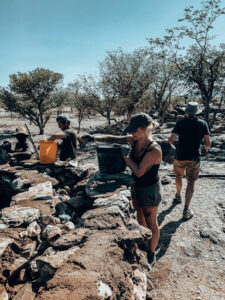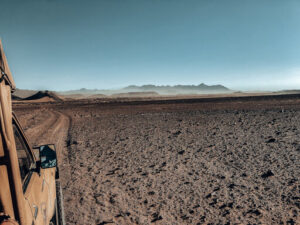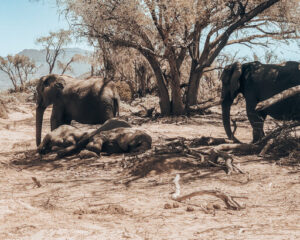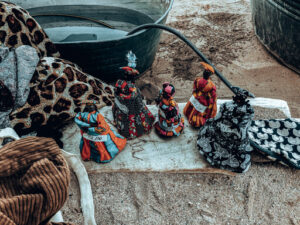Guest Blogger Ráchelle-Jean wrote an article for us about her experience as a volunteer with a Wildlife Conservation Project!
My trip to Namibia was for the purpose to volunteer with an organization named EHRA (Elephant Human Relations Aid). This turned into being one of the most beautiful, impressive, and impactful travels I have made in my life. Volunteering with a wildlife conservation project not only helps you to make a positive impact on the world, but I believe it also makes a positive impact on ourselves. So, if you haven’t joined a wildlife conservation project before as a volunteer, here are my 10 reasons for doing it sometime in the future!
1. Make a direct impact
The first and foremost reason for volunteering is that you will make a direct impact. Contributing your time, money, and hard work all directly impact conservation efforts. Namibia is home to one of two groups of desert elephants in the world. They need help to contribute to their survival, much like many other species around the world.
2. Financially support an organization
Most wildlife conservation organizations rely heavily on the funds that they get from volunteers. Volunteers pay an amount to join a project. Not only are organizations able to use this money to give you an incredible experience, but they can also pay for staff and materials that they desperately need to do the amazing work they do. Without volunteers and the funds that come in from volunteers, organizations become fully dependent on government and donations, which usually isn’t enough to make a substantial impact.

3. Travel to incredible locations
Many wildlife conservation projects will take you to the most amazing locations. They are of course striving to protect and support wildlife and these locations are usually in remote and off the beaten track locations. During my volunteer trip to Namibia, we spent our elephant patrol week out in the most remote locations of Damaraland, which is in the northern region of the Namib Desert. Most days we saw no other people at all, and the landscape was absolutely breathtaking.
4. Get disconnected from the online world
During wildlife conservation projects you will probably be disconnected from the outside world. Not only will you probably not see another tourist due to the remote location, but it will also be very hard to find an internet connection. This does come with many positives. You get to fully immerse yourself in the experiences and environment. When out in Damaraland in Namibia the nights were so quiet except for the odd animal noises such as baboons screaming down the dried riverbed. But also due to the low light pollution out in the desert, the night sky was incredible. We could clearly see the milky way.

5. Meet like-minded people from around the world
During your volunteer trip, you will meet many like-minded people from around the world. All these people came to join, participate, and support the same cause as you. They care for the project just like you do, which gives an amazing feeling of solidarity. Also learning about everyone’s different backgrounds and cultures can be a very valuable experience.
6. Learn a lot about wildlife and nature
Not only will you be working during your trip, be prepared to learn a lot! During my trip to Namibia, I learned so much about elephants, local nature, and wildlife, as well as how to track animals. Learning about all these different tracks, animals and plants was a lot of fun. Also learning out in the field instead of out a book was incredible because you can see it right in front of you. A lot of the knowledge I learned in Namibia I can take with me and use on other wildlife trips in the future. When I was driving home one day in The Netherlands, I spotted a cormorant, which is a type of bird. The only reason why I recognized this bird is because we had spotted quite a few white-breasted cormorants in Namibia. Not only that but during a hike in the Netherlands, I spotted deer tracks and tried to track it as far as I could. It was such an adventure to put the things I learned in Namibia to the test back home.

7. Get hands-on working experience
As a volunteer, you can expect to get very hands-on with a wildlife conservation project. Organization also rely on all the extra work that volunteers can provide. During my trip to Namibia, the first week was known as build week. During this week we as volunteers had to collect large rocks, mix cement, and build a protection wall for a farmer’s water source. These water sources need to be protected from thirsty elephants, which can get quite destructive in their search for water, in turn making communities very hostile towards the elephants.
8. Connect with nature in deeper way than on a holiday
During a wildlife conservation volunteer trip, you aren’t only traveling to see wildlife and nature. You are trying to make a positive contribution to the survival of certain nature and wildlife species. This mission makes you connect with the habitats and species so much more. You truly appreciate the animals you have come to help and the environment they call home. When we were out on our build and later our patrol week, we made sure to also leave no trace of humans behind. For our leftover foods scraps, we dug a bio-pit to bury these scraps deep in the ground so that animals wouldn’t get a taste for human food. Also, when going to the “toilet”, if you needed to do a number two, you were required to dig a hole and fill it up afterward. All toilet paper needed to be burnt, to leave no trace of our visit behind.

9. Meet Locals
Most organization will also work with locals. Having people from local communities working in their teams is essential in supporting their local communities and educating them. So not only will you probably be working with some locals, you will meet some along the way. In Namibia, we worked with many people from the local communities. They assisted us on our build and patrol week. Also, during our time at the project, we saw many people from the Himba tribe, the women from this tribe are decorated so beautifully with red clay. Also, Elle was a local Herero woman who washes the volunteers’ clothing after build-week for a small payment. She was dressed in beautiful bright clothing with the signature Herero woman horned hat.
10. Get up close with wildlife
During your trip, you are most likely to get up close to wildlife, of course in a respectful manner. During our trip, we came very close to a herd of desert elephants who also had two younger females present, who were laying on the ground having a nap. The volunteer group the weeks prior to our trip had witnessed elephants walking straight through basecamp.

Written by: Ráchelle-Jean Steenberg (from Tales of Odyssey)


